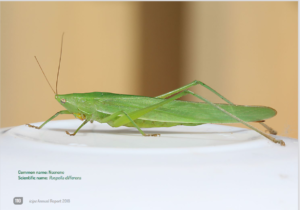RSIF 10th Webinar: Potential of underutilized food resources: Insects for food, feed and other uses
Africa, especially Sub-Saharan Africa region is highly biodiverse with large rural populations that are highly dependent on nature, livestock, agriculture as well as consumption of insects and wildlife products. This not only creates a heavy burden on the biodiversity, it also threatens livelihoods because of the human activities that contribute to climate change and Food insecurity.
Through the flagship programme of the Partnership for Skills in Applied Sciences, Engineering and Technology (PASET), the Regional Scholarship and Innovation Fund (RSIF) runs monthly webinar series aimed at promoting information and skills sharing in its five thematic areas.
The 10th webinar of its series which took place on 28th April 2021, aimed at helping participants understand the under utilised food resource potential in insects and their other uses. The webinar was based on research conducted on insects as a very important source of protein in the wake of food insecurity.
The guest speaker Dr Chrysantus M. Tanga a research scientist with the Insect for Food, Feed and Other Uses (INSEFF) programme at the International Centre of Insect Physiology and Ecology (icipe) started by introducing participants to icipe’s research for development framework on Insects as Food and Feed,then general understanding of edible insects and the role they can play as an alternative source of protein to both human beings an Animals.
The Value of insects for food and feed
He could not emphasise enough the importance of insect protein, saying that research had shown that it was between 28-73% higher than plant protein and more superior to animal protein, in addition to being rich in iron and zinc. There are 1900 species of edible insects being consumed by approximately 2 billion people globally and Africa is the hotspot, with 45 countries and approximately 330million people actively consuming 552 species of insects as food. He added that two news edible species of crickets (Scapsipedus and Gryllus madagascariensis) have been discovered and research is being conducted.
The Democratic Republic of Congo (DRC), Cameroon, South Africa, Zimbabwe and Zambia are some of the biggest consumers of insects in Africa. Understanding how different communities use insects for food and feed is critical in informing research on consuming patterns, seasons, benefits and cultural norms around both edible and non-edible insects.
For communities that eat insects, we promote them as food and for communities that do not eat insects, we promote them as animal feeds, so that we enhance mass adoption across the board without leaving anyone behind, said Dr Chrysantus M. Tanga
Some of the benefits of insects include the fact that they are an excellent alternative source of protein, extremely rich in minerals, excellent source of oils for bakery and other nutraceutical products, excellent source of therapeutic sterols in addition to having the potential for development of innovative products and income generation.

The RSIF webinar series are important forums for capacity building and creating synergies for partnerships and collaboration. Listen to the complete 10th webinar Serie on the “Potential of Underutilized Food Resources: Insects for Food, Feed and Other Uses” by clicking this Link (Access Passcode: SU^%X^N3).
For more information of how to participate in the RSIF webinar series, please contact Mr. Nyagah Bonface Karugah via bnyagah@icipe.org

